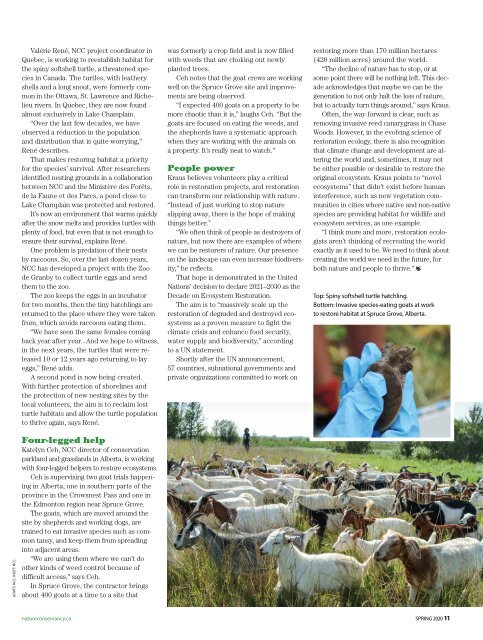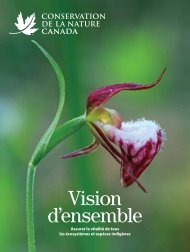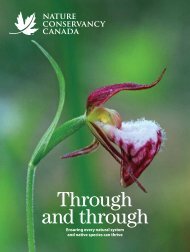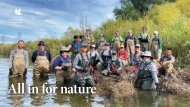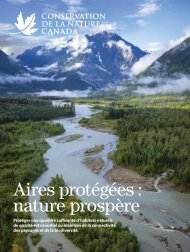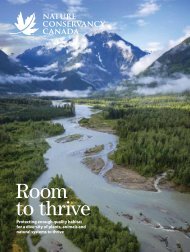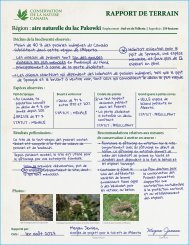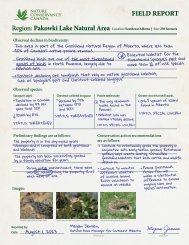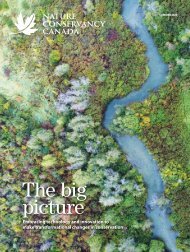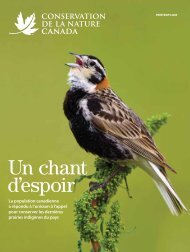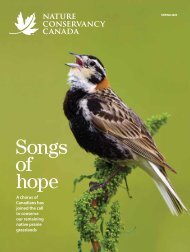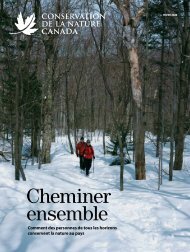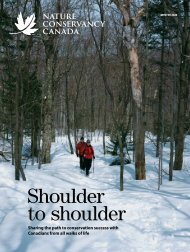You also want an ePaper? Increase the reach of your titles
YUMPU automatically turns print PDFs into web optimized ePapers that Google loves.
Valérie René, <strong>NCC</strong> project coordinator in<br />
Quebec, is working to reestablish habitat for<br />
the spiny softshell turtle, a threatened species<br />
in Canada. The turtles, with leathery<br />
shells and a long snout, were formerly common<br />
in the Ottawa, St. Lawrence and Richelieu<br />
rivers. In Quebec, they are now found<br />
almost exclusively in Lake Champlain.<br />
“Over the last few decades, we have<br />
observed a reduction in the population<br />
and distribution that is quite worrying,”<br />
René describes.<br />
That makes restoring habitat a priority<br />
for the species’ survival. After researchers<br />
identified nesting grounds in a collaboration<br />
between <strong>NCC</strong> and the Ministère des Forêts,<br />
de la Faune et des Parcs, a pond close to<br />
Lake Champlain was protected and restored.<br />
It’s now an environment that warms quickly<br />
after the snow melts and provides turtles with<br />
plenty of food, but even that is not enough to<br />
ensure their survival, explains René.<br />
One problem is predation of their nests<br />
by raccoons. So, over the last dozen years,<br />
<strong>NCC</strong> has developed a project with the Zoo<br />
de Granby to collect turtle eggs and send<br />
them to the zoo.<br />
The zoo keeps the eggs in an incubator<br />
for two months, then the tiny hatchlings are<br />
returned to the place where they were taken<br />
from, which avoids raccoons eating them.<br />
“We have seen the same females coming<br />
back year after year...And we hope to witness,<br />
in the next years, the turtles that were released<br />
10 or 12 years ago returning to lay<br />
eggs,” René adds.<br />
A second pond is now being created.<br />
With further protection of shorelines and<br />
the protection of new nesting sites by the<br />
local volunteers, the aim is to reclaim lost<br />
turtle habitats and allow the turtle population<br />
to thrive again, says René.<br />
was formerly a crop field and is now filled<br />
with weeds that are choking out newly<br />
planted trees.<br />
Ceh notes that the goat crews are working<br />
well on the Spruce Grove site and improvements<br />
are being observed.<br />
“I expected 400 goats on a property to be<br />
more chaotic than it is,” laughs Ceh. “But the<br />
goats are focused on eating the weeds, and<br />
the shepherds have a systematic approach<br />
when they are working with the animals on<br />
a property. It’s really neat to watch.”<br />
People power<br />
Kraus believes volunteers play a critical<br />
role in restoration projects, and restoration<br />
can transform our relationship with nature.<br />
“Instead of just working to stop nature<br />
slipping away, there is the hope of making<br />
things better.”<br />
“We often think of people as destroyers of<br />
nature, but now there are examples of where<br />
we can be restorers of nature. Our presence<br />
on the landscape can even increase biodiversity,”<br />
he reflects.<br />
That hope is demonstrated in the United<br />
Nations’ decision to declare 2021–2030 as the<br />
Decade on Ecosystem Restoration.<br />
The aim is to “massively scale up the<br />
restoration of degraded and destroyed ecosystems<br />
as a proven measure to fight the<br />
climate crisis and enhance food security,<br />
water supply and biodiversity,” according<br />
to a UN statement.<br />
Shortly after the UN announcement,<br />
57 countries, subnational governments and<br />
private organizations committed to work on<br />
restoring more than 170 million hectares<br />
(420 million acres) around the world.<br />
“The decline of nature has to stop, or at<br />
some point there will be nothing left. This decade<br />
acknowledges that maybe we can be the<br />
generation to not only halt the loss of nature,<br />
but to actually turn things around,” says Kraus.<br />
Often, the way forward is clear, such as<br />
removing invasive reed canarygrass in Chase<br />
Woods. However, in the evolving science of<br />
restoration ecology, there is also recognition<br />
that climate change and development are altering<br />
the world and, sometimes, it may not<br />
be either possible or desirable to restore the<br />
original ecosystem. Kraus points to “novel<br />
ecosystems” that didn’t exist before human<br />
interference, such as new vegetation communities<br />
in cities where native and non-native<br />
species are providing habitat for wildlife and<br />
ecosystem services, as one example.<br />
“I think more and more, restoration ecologists<br />
aren’t thinking of recreating the world<br />
exactly as it used to be. We need to think about<br />
creating the world we need in the future, for<br />
both nature and people to thrive.”2<br />
Top: Spiny softshell turtle hatchling.<br />
Bottom: Invasive species-eating goats at work<br />
to restore habitat at Spruce Grove, Alberta.<br />
GOATS: <strong>NCC</strong>. INSET: <strong>NCC</strong>.<br />
Four-legged help<br />
Katelyn Ceh, <strong>NCC</strong> director of conservation<br />
parkland and grasslands in Alberta, is working<br />
with four-legged helpers to restore ecosystems.<br />
Ceh is supervising two goat trials happening<br />
in Alberta, one in southern parts of the<br />
province in the Crowsnest Pass and one in<br />
the Edmonton region near Spruce Grove.<br />
The goats, which are moved around the<br />
site by shepherds and working dogs, are<br />
trained to eat invasive species such as common<br />
tansy, and keep them from spreading<br />
into adjacent areas.<br />
“We are using them where we can’t do<br />
other kinds of weed control because of<br />
difficult access,” says Ceh.<br />
In Spruce Grove, the contractor brings<br />
about 400 goats at a time to a site that<br />
natureconservancy.ca<br />
SPRING <strong>2020</strong> 11


